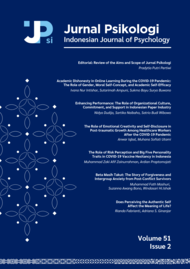Perfectionism and Eating Disorder Tendencies In Calorie-Tracking App Users
Talitha Sahda Sabina(1*), Lavenda Geshica(2)
(1) Faculty of Psychology, Universitas Gadjah Mada, Yogyakarta, Indonesia
(2) Faculty of Psychology, Universitas Gadjah Mada || School of Health and Wellbeing at the University of Glasgow, UK.
(*) Corresponding Author
Abstract
Keywords
Full Text:
PDFReferences
American Psychiatric Association. (2013). Diagnostic and statistical manual of mental disorders (5th ed.). https://doi.org/10.1176/appi.books.9780890425596
Bailey, P., Purcell, S., Calvar, J., & Baverstock, A. (2021). Actions & interventions for weight loss. Ipsos. https://www.ipsos.com/sites/default/files/ct/news/documents/2021-01/node-754001-754886.zip
Barnett, M. D., & Sharp, K. J. (2016). Maladaptive perfectionism, body image satisfaction, and disordered eating behaviors among U.S. college women: The mediating role of self-compassion. Personality and Individual Differences, 99, 225–234. https://doi.org/10.1016/j.paid.2016.05.004
Brandsma, L. (2007). Eating disorders across the life span. Journal of Women & Aging, 19(1–2), 155–172. https://doi.org/10.1300/j074v19n01_10
Brown, A. J., Parman, K. M., Rudat, D. A., & Craighead, L. W. (2012). Disordered eating, perfectionism, and food rules. Eating Behaviors, 13(4), 347–353. https://doi.org/10.1016/j.eatbeh.2012.05.011
Chang, E. C., Ivezaj, V., Downey, C. A., Kashima, Y., & Morady, A. R. (2008). Complexities of measuring perfectionism: Three popular perfectionism measures and their relations with eating disturbances and health behaviors in a female college student sample. Eating Behaviors, 9(1), 102–110. https://doi.org/10.1016/j.eatbeh.2007.06.003
Eikey, E. V., & Reddy, M. C. (2017). "It's definitely been a journey": A qualitative study on how women with eating disorders use weight loss apps. In Proceedings of the 2017 CHI Conference on Human Factors in Computing Systems (pp. 642–654). Association for Computing Machinery. https://doi.org/10.1145/3025453.3025591
Eikey, E. V. (2021). Effects of diet and fitness apps on eating disorder behaviours: Qualitative study. BJPsych Open, 7(5), e152. https://doi.org/10.1192/bjo.2021.1011
Fang, T., & Liu, F. (2022). A review on perfectionism. Open Journal of Social Sciences, 10, 355–364. https://doi.org/10.4236/jss.2022.101027
Fairburn, C. G., Cooper, Z., & Shafran, R. (2003). Cognitive behaviour therapy for eating disorders: A “transdiagnostic” theory and treatment. Behaviour Research and Therapy, 41(5), 509–528. https://doi.org/10.1016/S0005-7967(02)00088-8
Forbush, K., Heatherton, T. F., & Keel, P. K. (2007). Relationships between perfectionism and specific disordered eating behaviors. International Journal of Eating Disorders, 40(1), 37–41. https://doi.org/10.1002/eat.20310
Forrester-Knauss, C., & Stutz, E. Z. (2012). Gender differences in disordered eating and weight dissatisfaction in Swiss adults: Which factors matter? BMC Public Health, 12, 809. https://doi.org/10.1186/1471-2458-12-809
Garner, D. M., Olmsted, M. P., Bohr, Y., & Garfinkel, P. E. (1982). The Eating Attitudes Test: Psychometric features and clinical correlates. Psychological Medicine, 12(4), 871–878. https://doi.org/10.1017/S0033291700049163
Hamamoto, Y., Motoki, K., & Sugiura, M. (2020). Assessing the relationship between drive for thinness and taste–shape correspondences. Multisensory Research, 34(1), 69–92. https://doi.org/10.1163/22134808-bja10030
Hewitt, P. L., & Flett, G. L. (1991). Perfectionism in the self and social contexts: Conceptualization, assessment, and association with psychopathology. Journal of Personality and Social Psychology, 60(3), 456–470. https://doi.org/10.1037/0022-3514.60.3.456
Hewitt, P. L., Flett, G. L., & Ediger, E. (1995). Perfectionism traits and perfectionistic self-presentation in eating disorder attitudes, characteristics, and symptoms. International Journal of Eating Disorders, 18(4), 317–326. https://doi.org/10.1002/1098-108x(199512)18:4
Honary, M., Bell, B. T., Clinch, S., Wild, S. E., & McNaney, R. (2019). Understanding the role of healthy eating and fitness mobile apps in the formation of maladaptive eating and exercise behaviors in young people. JMIR mHealth and uHealth, 7(6), e14239. https://doi.org/10.2196/14239
Kline, P. (1986). A handbook of test construction: Introduction to psychometric design. Routledge.
Linardon, J., & Messer, M. (2019). My fitness pal usage in men: Associations with eating disorder symptoms and psychosocial impairment. Eating Behaviors, 33, 13–17. https://doi.org/10.1016/j.eatbeh.2019.02.003
Mandiri, A. D. (2015). Uji validitas konstruk pada alat ukur Eating Attitudes Test (EAT-26). Jurnal Pengukuran Psikologi dan Pendidikan Indonesia, 4(4). https://doi.org/10.15408/jp3i.v4i4.9308
Mitchison, D., Hay, P., Slewa-Younan, S., & Mond, J. (2012). Time trends in population prevalence of eating disorder behaviors and their relationship to quality of life. PLOS One, 7(11), e48450. https://doi.org/10.1371/journal.pone.0048450
Oltmanns, T. F., & Emery, R. E. (2019). Abnormal psychology (9th ed.). Pearson.
Pengpid, S., & Peltzer, K. (2018). Risk of disordered eating attitudes and its relation to mental health among university students in ASEAN. Eating and Weight Disorders – Studies on Anorexia, Bulimia and Obesity, 23(3), 349–355. https://doi.org/10.1007/s40519-018-0507-0
Piran, N., McVey, G., & Levine, M. P. (2014). Eating disorders in adolescence. In T. P. Gullotta & M. Bloom (Eds.), The encyclopedia of primary prevention and health promotion (2nd ed.). Kluwer Academic/Plenum Publishing.
Populix. (2022). Unveiling Indonesian beauty & dietary lifestyle. https://info.populix.co/en/report/unveiling-indonesian-beauty-dietary-lifestyle/
Safitri, S., & Preston, M. (2020). The development of Indonesian Multidimensional Perfectionism Scale for senior high school students. In Proceedings of the International Conference on Religion and Mental Health (ICRMH 2019). EAI. https://doi.org/10.4108/eai.18-9-2019.2293362
Simpson, C. C., & Mazzeo, S. E. (2017). Calorie counting and fitness tracking technology: Associations with eating disorder symptomatology. Eating Behaviors, 26, 89–92. https://doi.org/10.1016/j.eatbeh.2017.02.002
Sirois, F. M. (2016). Perfectionism and health behaviors: A self-regulation resource perspective. In F. M. Sirois & D. S. Molnar (Eds.), Perfectionism, health, and well-being (pp. 45–67). Springer. https://doi.org/10.1007/978-3-319-18582-8_3
Striegel-Moore, R. H., Rosselli, F., Perrin, N., DeBar, L., Wilson, G. T., May, A., & Kraemer, H. C. (2009). Gender difference in the prevalence of eating disorder symptoms. International Journal of Eating Disorders, 42(5), 471–474. https://doi.org/10.1002/eat.20625
Tongco, M. D. C. (2007). Purposive sampling as a tool for informant selection. Ethnobotany Research and Applications, 5, 147–158. https://doi.org/10.17348/era.5.0.147-158
Wade, T. D., & Tiggemann, M. (2013). The role of perfectionism in body dissatisfaction. Journal of Eating Disorders, 1, 2. https://doi.org/10.1186/2050-2974-1-2
Article Metrics
Refbacks
- There are currently no refbacks.
Copyright (c) 2025 Jurnal Psikologi

This work is licensed under a Creative Commons Attribution-ShareAlike 4.0 International License.
Recent Issues
 |  |  |  | ||||
| Vol 51 Issue 2 (2024) Page 120-230 | Vol 51 Issue 1 (2024) Page 1-119 | Vol 50 Issue 3 (2023) Page 219-332 | Vol 50 Issue 2 (2023) Page 125-218 |
| Published by Faculty of Psychology, Universitas Gadjah Mada, Indonesia Building D-6th, Floor No. D-606. Jl. Sosio Humaniora No. 1, Bulaksumur Yogyakarta, 55281 Email: jurnalpsikologi@ugm.ac.id Phone/whatsApp: +6281125210175 |











